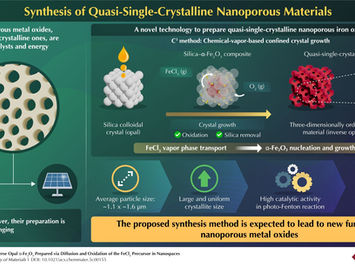top of page
NEWS - MATERIALS SCIENCE
AI | BUSINESS | CHEMISTRY | COMPUTING | ELECTRONICS | ENERGY | ENGINEERING | LIFE SCIENCE | MATERIAL SCIENCE | METROLOGY | PHOTONICS | PHYSICS | QUANTUM TECH | ROBOTICS | SEMICONDUCTOR


Twisted graphene reveals exotic superconductivity
EPFL physicists and their collaborators have directly observed and controlled a rare double-dome pattern of superconductivity in twisted trilayer graphene, shedding light on how exotic quantum states emerge and interact in engineered materials. Superconductivity is a phenomenon where certain materials can conduct electricity with zero resistance. Obviously, this has enormous technological advantages, which makes superconductivity one of the most intensely research fields in t


Understanding orderly and disorderly behavior in 2D nanomaterials could enable bespoke design, tailored by AI
Since their discovery at Drexel University in 2011, MXenes — a family of nanomaterials with unique properties of durability, conductivity and filtration, among many others — has become the largest known and fastest growing family of two-dimensional nanomaterials, with more than 50 unique MXene materials discovered to date. Experimentally synthesizing them and testing the physical properties of each material has been the labor of tens of thousands of scientists from more than


Cracking graphene’s quantum code
For several decades, a central puzzle in quantum physics has remained unsolved: Could electrons behave like a perfect, frictionless fluid with electrical properties described by a universal quantum number? This unique property of electrons has been extremely difficult to detect in any material so far because of the presence of atomic defects, impurities, and imperfections in the material. Researchers at the Department of Physics, Indian Institute of Science (IISc), along with


A novel technology to control crystallinity of pore walls
Nanoporous metal oxides have a wide variety of applications, such as catalysts, electrodes, energy materials, sensors, and biomaterials. Recently, a team of researchers has demonstrated a novel synthesis method for their efficient and desirable preparation. Specifically, they prepared difficult-to-prepare quasi-single-crystalline inverse opal α-Fe2O3, demonstrating that crystal growth occurs in nanospace due to volatilization and oxidation of metal chlorides. This technology


Scientists discover a new crystal that breathes oxygen
A team of scientists from Korea and Japan has discovered a new type of crystal that can "breathe"—releasing and absorbing oxygen repeatedly at relatively low temperatures. This unique ability could transform the way we develop clean energy technologies, including fuel cells, energy-saving windows, and smart thermal devices. The newly developed material is a special kind of metal oxide made of strontium, iron, and cobalt. What makes it extraordinary is that it can release oxyg


Study sheds light on graphite’s lifespan in nuclear reactors
New research uncovered a link between properties of graphite and how the material behaves in response to radiation. It seems like after graphite is irradiated for so long, it starts recovering.


MXene as a frame for 2D water films shows new properties
An international team led by Dr. Tristan Petit and Prof. Yury Gogotsi has investigated MXene with confined water and ions at BESSY II. In the MXene samples, a transition between localised ice clusters to quasi-two-dimensional water films was identified by increasing temperature. The team also discovered that the intercalated water structure drives a reversible transition from metallic to semiconducting behaviour of the MXene film. This could enable the development of novel de


First real-time observation of two-dimensional melting process
What occurs during the melting process in two-dimensional systems at the microscopic level? Researchers at Johannes Gutenberg University Mainz (JGU) have explored this phenomenon in thin magnetic layers. "By utilizing skyrmions, i.e., miniature magnetic vortices, we were able to directly observe, for the first time, the transition of a two-dimensional ordered lattice structure into a disordered state at the microscopic level in real time," explained Raphael Gruber, who conduc


Breakthrough in 2.5D MOF materials based on triptycene derivatives
Researchers at Kumamoto University and Nagoya University have developed a new class of two-dimensional (2D) metal-organic frameworks (MOFs) using triptycene-based molecules, marking a breakthrough in the quest to understand and enhance the physical properties of these promising materials. This innovation opens new possibilities for multifunctional applications in gas/molecular sensors, electrochemical energy storage, and spintronic devices. Two-dimensional (2D) conductive met


Controlling Polymer shapes: A new generation of shape-adaptive materials
What if a complex material could reshape itself in response to a simple chemical signal? A team of physicists from the University of Vienna and the University of Edinburgh has shown that even small changes in pH value and thus in electric charge can shift the spatial arrangement of closed ring-shaped polymers (molecular chains) – by altering the balance between twist and writhe, two distinct modes of spatial deformation. Their findings, published in Physical Review Letters, d


Irish scientists unlock nature’s 500-million-year-old colour secrets with nano-tech breakthrough
Half a billion years ago nature evolved a remarkable trick: generating vibrant, shimmering colours via intricate, microscopic structures in feathers, wings and shells that reflect light in precise ways. Now, researchers from Trinity have taken a major step forward in harnessing it for advanced materials science. A team, led by Professor Colm Delaney from Trinity’s School of Chemistry and AMBER, the Research Ireland Centre for Advanced Materials and BioEngineering Research, ha


Scalable supercapacitor technology made from graphene
Pure graphene for industrial applications is usually obtained from graphite. Conventional production methods have a very low yield of pure graphene, which has to be separated from waste products at great expense. However, thanks to a previous research project, the Empa researchers have an ace up their sleeve: They developed a process with which high-quality graphene can be “exfoliated” from graphite both cost-effectively and efficiently, and processed into a gel-like printabl
bottom of page
